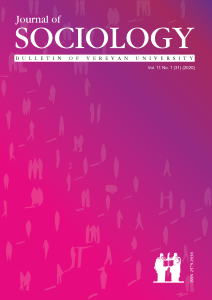Public Awareness and Participation in Local Selfgovernance in Armenia
Comparative Analysis for 2015 and 2019
DOI:
https://doi.org/10.46991/BYSU:F/2020.11.1.036Keywords:
Community participation, public awareness, cluster analysis, measurement model, index constructionAbstract
Raising public awareness and active participation in local self-government is a key component of governance instruments, public organizations and social initiatives in Armenia aimed at achieving “good governance” and strengthening democracy. However, there is no interest in the local self-government system in the Armenian society. This study analyzes the degree of public awareness of LSG and its participation in it in a comparative perspective for 2015 and 2019. In particular, the article is aimed at identifying the structure of the Armenian society using two main dimensions: public awareness of LSG and participation in LSG. For the existing variables, public participation in LSG was impossible to measure, while the result of measuring public awareness of LSG was sufficient. One separate variable was chosen as an indicator of participation in LSG. An index of public awareness about LSG was created. The cluster analysis revealed three clusters that make up society in 2015 and four clusters for 2019. The analysis showed that the overwhelming majority of the population has a low level of knowledge about LSG and public participation both in 2015 and 2019. In 2015, only 2.4% of the population had a high level of participation and awareness of LSG, which dropped to 1.8% in 2019.
References
Kosecik M. & Sagbas I. (2004) Public Attitudes to Local Government in Turkey: Research on Knowledge, Satisfaction and Complaints, Local Government Studies, 30: 3, pp. 360-383. Doi: https://doi.org/10.1080/0300393042000310444
Bartoletti, R. & Faccioli, F. (2016) Public Engagement, Local Policies, and Citizens’ Participation: An Italian Case Study of Civic Collaboration, SI: Media, Participation and Social Change, pp. 1–11. Doi: https://doi.org/10.1177/2056305116662187
Dalton, R. J. (2008) Citizenship norms and the expansion of political participation, Political Studies, 56, pp. 76–98. Doi: https://doi.org/10.1111/j.1467-9248.2007.00718.x
Rondinelli, A. D. (2006) Public administration and democratic governance: Governments serving citizens, United Nation Publications, United Neighborhood Centers of America.
Inglehart, R. (2006) Mapping Global Values, Comparative Sociology 5 (2-3), pp. 115-136. Doi: https://doi.org/10.1163/156913306778667401
Weßels, B. (2004) The development of civil society in Central and Eastern Europe: intermediary actors, trust and participation. In D. Gosewinkel, D. Rucht, W. van den Daele & J. Kocka (Edscivil) society – national und transnational, Berlin, pp. 173-199.
Griesshaber, N. (2014) Forms of Civic Engagement and Corruption: Disentangling the Roles of Voluntary Associations, Elite challenging Mass Movements and the Type of Trust within Social Networks, World Values Research 7(1), pp. 1-23.
O’Connell, M. (2003) Anti ‘Social Capital. Civic Values versus Economic Equality in the EU, European Sociological Review 19(3), Princeton, Princeton University Press, pp. 241-248. Doi: https://doi.org/10.1093/esr/19.3.241.
Welzel, C., Inglehart, R. & Deutsch, F. (2005) Social Capital, Voluntary Associations and Collective Action: Which Aspects of Social Capital Have the Greatest ‘Civic’ Payoff?, Journal of Civil Society, 1(2), pp. 121-146. Doi: https://doi.org/10.1080/17448680500337475
Gaventa J. & Barrett G. (2012) Mapping the Outcomes of Citizen Engagement, World Development Vol. 40, No. 12, pp. 2399–2410. Doi: https://doi.org/10.1016/j.worlddev.2012.05.014
Kuehnast, K. (2001) Protection, Participation, and Public Awareness: Indonesia Coral Reef Rehabilitation and Management Project. Social Development Notes; No.57., Washington, The World Bank.
Maykova E. & Simonova E. (2015) The Participation of Russian Citizens in Local Self-government: Potential and Real-life Social Practices, International Journal of Economics and Financial Issues, 5(Special Issue), pp.142-150.
Merrifield, J. (2001) Learning Citizenship, Discussion Paper prepared for Institute of Development Studies Participation Group and Society for Participatory Research in Asia, London: Learning from Experiences Trust, Goldsmiths College.
Esenaliev D. & Kisunko G. (2015) Local Budget Transparency and Participation Evidence from the Kyrgyz Republic, Policy Research Working Paper, World Bank Group. Doi: https://doi.org/10.1596/1813-9450-7154
Salamadze, V. (2009) Citizen Participation in Self-Governance, Civil Society Institute.
Sukiasyan M. (2016) Determining the Factors Influencing Residents’ Awareness and Knowledge about Local Self-Government Body’s Activities in Armenia, CRRC Armenia, Yerevan.
Tavokol M. & Dennick R. (2011) Making sense of Cronbach’s alpha, International Journal of Medical Education, 2, pp.53-55. Doi: https://doi.org/10.5116/ijme.4dfb.8dfd
Mazziotta M. & Pareto A. (2013) Methods for Constructing Composite Indices: one for all or all for one? Rivista Italiana di Economia Demografia e Statistica, Volume LXVII n. 2.
Nicoletti G., Scarpetta S. & Boylaud O. (2000) Summary indicators of product market regulation with an extension to employment protection legislation, OECD, Economic De-partments Working Papers, No. 226, p. 86. Doi: https://doi.org/10.2139/ssrn.201668
Downloads
Published
How to Cite
Issue
Section
License
Copyright (c) 2020 Sonya Msryan

This work is licensed under a Creative Commons Attribution-NonCommercial 4.0 International License.








